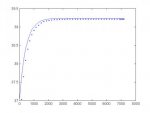Hi there
This is my first time trying this webpage
I have this equation: , with x(0) = E
, with x(0) = E
Here x(t) is the output, D is the input
By taking Laplace transform, first with D = 0 and x(0) = E, then D = D and x(0) = 0 I get these two equations:
 and
and  So the final answer for X(S) would be the sum of these two or
So the final answer for X(S) would be the sum of these two or 
Now I know that x(t) = G(s)u(t) .. how can I find G(s) ? (I'm assuming I haven't done anything wrong up till now, unless you can find a error somewhere?)
This is a part of an assignment of Parametric Signal Identification which I've done, but I can't verify my solution unless I can derive the transfer function (Or state space model) to put into SimuLink.
I at least know that the input is a step and the output looks like the output for a first-order system.
You would be of great help if you can help me with this, it's really embarrassing to go through really hard PSI methods, and then get stuck on the small matter of a simple Transfer Function!
This is my first time trying this webpage
I have this equation:
Here x(t) is the output, D is the input
By taking Laplace transform, first with D = 0 and x(0) = E, then D = D and x(0) = 0 I get these two equations:
Now I know that x(t) = G(s)u(t) .. how can I find G(s) ? (I'm assuming I haven't done anything wrong up till now, unless you can find a error somewhere?)
This is a part of an assignment of Parametric Signal Identification which I've done, but I can't verify my solution unless I can derive the transfer function (Or state space model) to put into SimuLink.
I at least know that the input is a step and the output looks like the output for a first-order system.
You would be of great help if you can help me with this, it's really embarrassing to go through really hard PSI methods, and then get stuck on the small matter of a simple Transfer Function!

